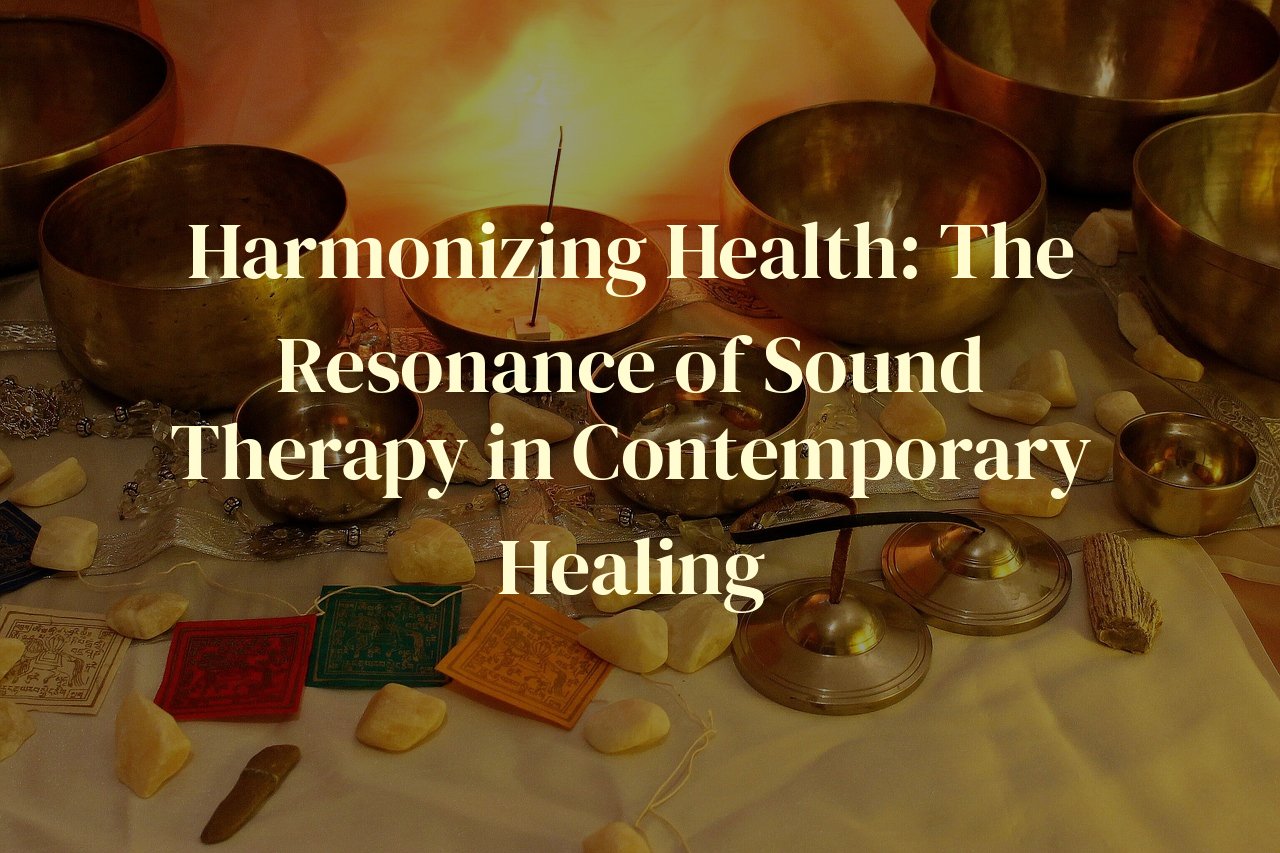
The symphony of life extends beyond the audible, encompassing a spectrum of vibrations that touch every aspect of our being. In this blog, we delve into the intriguing world of sound frequencies and their increasingly prominent role in modern medicine. By exploring ‘Harmonizing Health: The Resonance of Sound Therapy in Contemporary Healing’, we will uncover the scientific underpinnings of sonic treatments and their therapeutic applications. Additionally, you will discover how integrating these soundscapes into your healthcare routine can offer tangible benefits, potentially reducing stress, alleviating pain, and promoting overall well-being.
Table of Contents
The Science of Sound: An Overview of Sonic Healing
The concept of sonic healing rests on the fundamental understanding that sound is vibration, and these vibrations can resonate with the body’s own cellular frequencies. Sonic healing, or sound therapy, harnesses specific sound frequencies to stimulate healing and promote wellbeing.
At the heart of sonic healing is the notion that every part of our body, down to the cellular level, is in a constant state of vibration. Disruption in these natural rhythms can lead to disharmony and disease. Sonic therapists believe that sound frequencies can reintegrate the body’s natural resonance, potentially restoring health. This principle is rooted in the ancient practice of using chants and singing bowls but has evolved with contemporary science.
One such scientific concept is entrainment, which is the synchronization of two or more rhythmic cycles. It proposes that low-frequency sound waves can encourage the brain to move into deeper states of relaxation, akin to meditation, thus promoting the body’s healing processes. Studies are increasingly exploring how these modulated vibrations not only affect psychological states but may also influence physiological recovery. For example, binaural beats and isochronic tones can induce states of concentration or relaxation, potentially aiding in stress-related conditions and pain management.
Furthermore, the application of sound waves goes beyond mere relaxation. Ultrasound, which is a high-frequency acoustic wave, is commonly used in physical therapy for tissue repair and in diagnostic imaging. This highlights the versatility of sound as a therapeutic agent, not limited to mental health but also encompassing a breadth of medical uses.
Incorporating my personal journey with sonic healing, I have experienced firsthand the soothing power of Tibetan singing bowls during particularly stressful times. The resonance they produce seems to envelop the mind and facilitates a profound inner calm, underscoring the effectiveness of applying ancient wisdom in modern therapeutic contexts.
Modern Applications: Sound Frequencies in Clinical Settings
The confluence of tradition and technology has given rise to novel applications of sound therapy within contemporary healthcare. Harnessing the intricate properties of sound, clinicians and researchers are exploring its potential in diverse therapeutic realms. From binaural beats designed to enhance relaxation and alleviate stress, to rhythmic acoustic stimulations aimed at improving cognitive function among patients with neurological conditions, sonic frequencies are orchestrated into clinical settings with precision and care.
Medical professionals have found that targeted sound frequencies can promote healing in wound care. Low-frequency, infrasound therapy has been studied for its capacity to accelerate tissue repair, thereby painting an acoustic adjunct to the conventional repertoire of wound management. Hospitals are also incorporating sound therapy to create a tranquil atmosphere for patients recovering from surgery or undergoing lengthy treatments, thus providing a serene sonic backdrop to facilitate the body’s innate healing processes.
Pioneers in oncology have integrated music therapy programs to assist in the emotional and physical well-being of cancer patients, using melody and rhythm as a conduit for communication and emotional release. Furthermore, the field of psychoacoustics is burgeoning, shedding light on how sound and music therapy can benefit those battling mental health conditions, ranging from anxiety and depression to more complex psychiatric disorders.
As a resonant example, my interaction with sound therapy in the clinical setting revealed its profound impact. A patient grappled with chronic pain, yet through consistent sound therapy applications, her pain perception was notably diminished, affirming the therapeutic resonance of sound. Each humming note and pulsating tone seemed to recalibrate her sensory pathways, offering a semblance of relief that traditional medications alone had yet to achieve.
Undeniably, the harmony between sound therapy and conventional medicine is amplifying. As we tune into the body’s subtle frequencies, we are but scratching the surface of an audiological symphony that holds the potential to revolutionize healing. The modern clinical applications of sound frequencies are thus not only a testament to medical innovation but to the enduring quest for a holistic approach to health that echoes with humanistic resonance.
Personal Symphony: My Experiences with Sonic Therapy
Embarking on a journey through the harmonious realm of sonic therapy, I found myself surrounded by a symphony of frequencies that promised to recalibrate my body’s rhythm. Personal encounters with sound therapy were transformative, with each session sculpting a unique narrative of healing. During my initial sessions, a sense of skepticism prevailed, but it swiftly dissipated as the vibrations began their invisible dance around my being. Soft, pulsating tones lulled my mind into a meditative state where stress seemed to evaporate into thin air.
Through my consistent sit-downs with a trained sound therapist, I was acquainted with various instruments such as Tibetan singing bowls, tuning forks, and gongs, each one orchestrating a unique role in my auditory healing process. The singing bowls, with their deep, resonant hums, brought a calming presence that seemed to penetrate deep into my core, addressing unrest at its source. Tuning forks, when struck, emitted precise frequencies that vibrated through my body, a sensation that some describe as aligning the body’s energetic highways.
On days clouded by anxiety, the gong’s resonant bellow, stark and commanding, would cut through the mental fog, leaving behind a sense of clarity. It was as though the sound waves were washing over me, clearing away the tension that was deeply rooted in my psyche. This direct encounter with the transformative power of sound was not just a passive experience; it became an active tool that empowered me to harmonize my inner landscape when the turbulence of life became too overwhelming.
Remarkably, these experiences with sonic therapy did not exist in isolation. They interwove beautifully with my daily practices of mindfulness and relaxation techniques, creating a comprehensive tapestry of wellness that reverberated beyond the therapy sessions. The fusion of sound waves and meditation amplified the benefits, augmenting my mental fortitude and resilience. In time, the sonic treatments that I underwent became less of a remedy and more of a lifestyle, a testament to the enduring impact of these cosmic vibrations on the human spirit.
In reflection, my personalized symphony of sonic therapy is a continuity of life’s ebb and flow—a reminder that in the midst of chaos, there’s a sound frequency that resonates with the very essence of healing and rejuvenation. It’s about allowing oneself to be attuned to the curative concert of life, acknowledging that every note holds the potential to synchronize our innermost selves with the universe’s grand orchestration.
Fine-Tuning Recovery: Combining Sound Therapy with Conventional Treatments
When we merge the ancient practice of sound therapy with the meticulous advancements of modern medicine, a symphony of holistic healing begins to play. In the delicate dance of patient care, this integration harmonizes the physiological with the psychological, fostering a recovery that can often feel more comprehensive and more humane. My experience in the healthcare space has allowed me to witness firsthand the transformative power of this union.
Sound therapy is not a stand-alone miracle; rather, it’s a remarkable adjunct that can amplify and support conventional treatments. For example, I’ve observed patients with chronic pain undergo a standard regimen of medication and physical therapy while incorporating binaural beats. These beats are said to induce states of deep relaxation and have been associated with pain relief. The patients reported not only a reduction in pain perception but also improvements in mood and sleep — vital components of the healing process.
Anxiety disorders also present an insightful narrative where coupling sound therapy with traditional approaches like cognitive-behavioral therapy and pharmacotherapy can have synergistic results. The gentle hum of Tibetan singing bowls may seem otherworldly, yet their vibrations work in harmony with the body’s natural rhythms, promoting inner peace that medication alone sometimes struggles to achieve.
Pulling from my own experiences with patients undergoing cancer treatments, the distress of chemotherapy can often be mitigated by the adjuvant use of soothing soundscapes. Whereas the chemo focuses on eliminating cancer cells, therapeutic sounds serve to nurture the patient’s spirit through the daunting journey, potentially improving adherence to treatment plans and enhancing overall quality of life.
The future of medical intervention must consider the patient as a whole. Tailoring sound therapy’s modalities — such as tuning fork therapy, the use of guided meditation with nature sounds, or structured music therapy sessions — to complement specific stages of recovery, affirms our commitment as healthcare providers to not only treat but truly heal. It’s within this dynamic interplay of sound and science where we witness the fullest potential of recovery, a reminder that healing is both an art and a science.
A Future in Harmony: The Evolving Landscape of Sonic Healing in Medicine
The burgeoning field of sonic healing reverberates with potential, heralding a transformative era in complementary and alternative medicine. Advances in technology and our deepening understanding of bioacoustics are forging new frontiers in the therapeutic use of sound. From my vantage as a health blogger and advocate for integrative healing practices, I’ve witnessed the embryonic threads of sonic medicine weave themselves into a more mature tapestry of viable healthcare options.
One striking innovation lies in the precision targeting of sound frequencies to disrupt cancerous cells. Although this technique is in its nascent stages, the potential to spare healthy cells while annihilating malignancies without resorting to invasive procedures is an exciting development. Meanwhile, the use of binaural beats and isochronic tones has emerged as a digital-age panacea to stress, anxiety, and sleep disorders, as personal testimonies and clinical studies attest to their efficacy.
Virtual reality environments coupled with curated soundscapes are another marvel in the making, offering immersive therapies that stimulate healing through a multisensory experience. These VR sanctuaries are designed to transport patients to tranquil settings, where the harmonies of nature and music coalesce, promoting mental well-being and stress reduction. This digital-organic synergy embodies how old-world elements can be reinvigorated through modern tech.
On the research anvil, cutting-edge studies are delving into the genetic impacts of sound, speculating the possibility of sonic frequencies that could influence gene expression and foster cellular regeneration. Although it is a field fraught with substantial scientific hurdles, the mere conception is a testament to how far the horizons of sonic healing have expanded.
As a final note of optimism, the eventual amalgamation of sound-based therapies into mainstream protocols could revolutionize patient-tailored care. In envisioning a future where every hospital room resonates with therapeutic tunes, calibrated to individual patient needs, we foresee a healthscape where the sound is not only the medicine for the soul but also for the body.
Conclusion
In conclusion, the harmonious integration of sound frequencies into the domain of modern medicine is not only an ode to ancient practices but also a testament to the innovation within healthcare. As a blogger deeply invested in the potential of dietary therapy and health common sense, I understand the need for holistic approaches to healing. Sonic healing is more than a passing melody; it is a resonant force capable of orchestrating profound changes in our journey to wellness. May the information bridged in this blog resonate with you, offering both enlightenment and practical pathways to harmonize your health.



